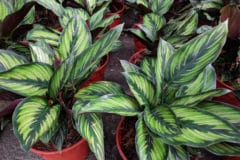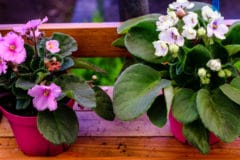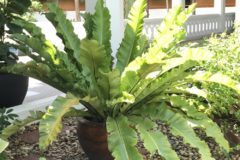Praying Marantas or Curling Calathea
While prayer plants and Calatheas both have strikingly variegated leaves, prayer plants have an another trait, and they don’t share this one with Calatheas. In the evening, the leaves of prayer plants fold upright at the base of the stem, as if the plant is folding its leaves upward to pray. In the morning, the leaves fold back down to catch the sun’s light. This is a natural, healthy behavior for the plant.
The leaves of Calatheas, however, sometimes curl up from the outer edges inward toward the central vein. While this is a natural behavior, it’s not a healthy one. It’s a sign of stress and neglect.
Why Calathea Leaves Curl
Calatheas originated in tropical environments with rainy seasons and high humidity, and they require similar conditions when they are growing in your home. If the leaves curl up, it’s because you’ve allowed the soil to become too dry or because the air is too dry.
What to Do When Calathea Leaves Curl
Check the soil and make sure that the soil is moist, not dry. While you can cut back on watering in the winter when the plant is not growing, you should still keep the soil moist year round.
If the soil is moist, then the problem is with the humidity level in the air. There are three possible solutions you can try:
- Mist the plant’s leaves as often as needed, daily if necessary.
- Move the plant to an area of your home where the humidity is higher.
- Place the plant on a pebble-filled watering tray.
Calatheas also are particularly susceptible to low humidity in the winter when the air is drier, especially in cooler climates where the problem is exacerbated by your home’s heating system. Calatheas like warmth, but not the sudden changes they might experience as the heat goes on and off, so move your calatheas away from your heating system’s heating ducts and cold air intakes to a place where the temperature is more stable.












